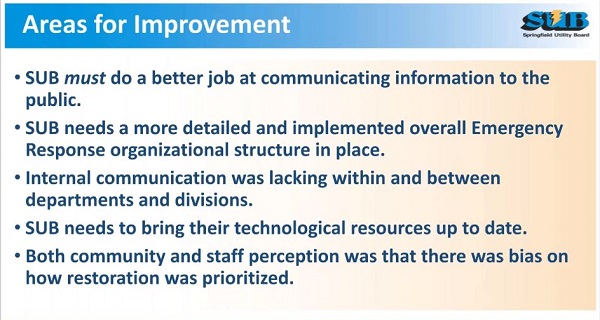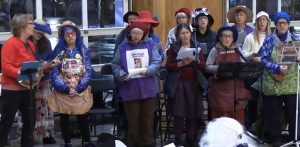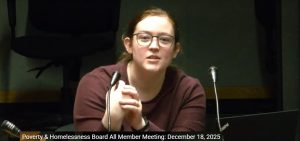Ice storm lessons learned: Springfield Utility Board
8 min read
The Springfield Utility Board looks at preliminary findings from its ice storm after-action report. On March 13:
Tracy Sutten (SUB, resource planning manager): Okay, so here is the first portion of the internal after- action report for the January 2024 ice storm. All staff, community members, the board were given a survey option, as well as a team of us met in face-to-face in-person meetings with smaller work groups.
[00:00:30] And we asked for feedback related to strengths and weaknesses related to their experience during the event. A team of five of us, we came up with a focus of the core services that SUB provided during the event: electric, water, customer service, public information and telecommunications. And then in thinking about those different areas, focusing on: safety, leadership, communications, training, and resources. So that was really the guidance that was given when asking for feedback.
[00:00:57] We as a team got together and aggregated all those comments and took together which comments kind of rose to the top and occurred the most and we aggregated those into themes: public communication, internal communication, organizational structure, capabilities and resource visibility, and availability.
[00:01:16] The report goes into what we mean by those. Each has definitions. Training and knowledge, technology, leadership, and then our relationships with the outside agencies.
[00:01:27] So here were just overall successes (and these are the opinions of my co-workers):
- So some employees showed an incredible level of commitment and character throughout the entire event, as seen internally and by the community.
- Designated staff stepped into predetermined roles and coordinated efforts within their divisions productively.
- SUB improved its processes for responding to large outage by implementing previous lessons learned from previous events.
- SUB did an outstanding job of providing sustenance for their teams in emergency response which helps everyone do their job more effectively.
[00:02:00] and those that rose to the top of the list for areas for improvement:
- SUB must do a better job of communicating information to the public.
- SUB needs a more detailed and implemented overall emergency response organizational structure in place.
- Internal communication was lacking within and between departments and divisions.
- SUB needs to bring their technological resources up to date.
- Both community and staff perceptions was that there was a bias on how restoration was prioritized.
[00:02:32] And the bottom line, really, is there was a tremendous effort by staff to restore service. And the most amazing part is that even after successfully restoring service, staff showed up engaged and fully willing to share their experience on how to develop lessons learned and be even better for the next event.
[00:02:54] And so this was the original finish line for the after-action report. Another thing that came up from the engaged employees is that they have a lot of ideas for solutions. And so that we after I give this presentation tomorrow, I will create another survey that will go out to all employees it’ll be optional. Because they do want to be part of the solution recommendations. With the caveat, of course not all those ideas will be implemented, but they are going to land on the list.
[00:03:24] And because there will probably be many, we’ll aggregate those into themes as well.
[00:03:31] John DeWenter (SUB board): You focused on SUB’s response to the ice storm. Has there been any focus on planning and preparation as opposed to response?
[00:03:43] Tracy Sutten (SUB, resource planning manager): That would be the outcome of those suggestions. So you can see I started to already populate the suggestions that have already started to come in. There have been suggestions for more training and for more culture of incident command, so people have already given those feedback. I don’t drive the themes. The themes are organic as a result of the customers, or of my co-workers’ opinions.
[00:04:11] David Willis (SUB vice chair): So, again, I like the the report. It is helpful. It raises some other questions in my mind. And then I happen to have been in on a couple of presentations by Public Works—city, county, I think I just happened to be there.
[00:04:26] The Public Works right across the street from the water, all of their gates were frozen shut, except for one, which happened to be left open, so they were able to get in and get the blowtorches. And they got me thinking about two things.
[00:04:39] Number one, if we don’t have power, they’re not able to have access. Number two, if they’re frozen shut, they’re frozen shut.
[00:04:49] Sanjeev King (SUB, director, electrical engineering and operations): We had lots of things that were frozen. And I will just say that there’s no one more resourceful than SUB linemen and we found a way and we will always find a way to make it work. So we got blowtorches, we used manual strength, we did what we had to do to get the job done.
[00:05:09] David Willis (SUB vice chair): So I guess to me the point is that things are going to happen that we don’t plan on and I realize we can’t plan for every contingency. But you know, part of the disaster planning /emergency planning is, you know, it’s actually in the planning. It’s learning how to plan and learning how to shift and how to pivot.
[00:05:29] I know that in the past, we’ve had tabletop exercises. And again, it’s much the exercise of learning how to pivot. Do we do table top with the county, city, things like that?
[00:05:44] Tracy Sutten (SUB, resource planning manager): We have not had a recent tabletop exercise… every year though, every fall, Electric goes through their ‘Large Outage’ document, which is their process. It’s not on the website because it’s not for the public. And each person that has a role in that outage event has an identified incident command role.
[00:06:04] In this case, this report was not of the scale, it was a much larger scale, and of those lessons learned, the solution feedback is that we need larger-scale incident command tabletop exercises. You’ll see that in the themes going forward on the solutions.
[00:06:20] David Willis (SUB vice chair): And so that kind of goes into the communication and in your report too, you basically mentioned, the communication needs to be better and could have been a lot better, so the tabletops, those are really critical and larger scale.
[00:06:34] Does SUB share tracing weather along with Public Works and the city? And that was part of the problem is that, you know, this ice storm, we don’t really have good NOAA information and it was a bomb that kind of dropped off. So it was a lot more intense than anybody thought. But the city is tracking the weather.
[00:06:56] Tracy Sutten (SUB, resource planning manager): As are we.
[00:06:57] David Willis (SUB vice chair): But do you communicate with each other about that? I mean, the information that they’re receiving, you’re receiving?
[00:07:07] Jeff Nelson (SUB general manager): Our primary conduit has been with the Oregon Public Utility Commission, and they have resources they brought in with NOAA, a northwest forecast that’s been in the Portland area. There have been folks in giving us weather updates what was occurring and what they were seeing. In terms of our direct communicating with the city on what’s happening with the weather, I’ll defer to the operations side of things.
[00:07:38] Sanjeev King (SUB, director, electrical engineering and operations): So the city’s emergency manager, he provides information to us (Ken Vogeney), Ken provides information to us which is basically the information that comes from this larger data from Portland. But he focuses on the part that’s for our area in the southern Willamette Valley. And so he provides that information regularly when there’s a sign of inclement weather, not just this situation, but throughout the year, whether it be a prediction of high winds, anything that’s projected to have infrastructure impact, he’s providing that to many of us as the electric leaders.
[00:08:19] Jeff Nelson (SUB general manager): As the city is seeing a weather event coming in,, they’re sharing information with us; as we’re seeing a weather event coming in, we’re also getting information through the Public Utilities Commission’s conduit. So yes, we’re sharing the same information.
[00:08:35] David Willis (SUB vice chair): So, not trying to get anybody in trouble, but the county person that I talked to felt that they, you know, if they had it over to do over again, they would have requested things more quickly. They felt that they were slow in terms of gathering information, things like that. Not necessarily our responsibility, but that was that.
[00:08:55] The one question I did have going back to the Public Works. So you had the Public Works coming in, they’re trying to identify, you’ve got trees down. they’re trying to clean the main artery. Then you have the issue of telephone poles. Telephone poles are down. They’re not going to touch those. But on the city level, so here you’ve got, you’ve got an issue where they’re trying to open up the arteries, but some arteries they can’t open up because they’ve got telephone poles.
[00:09:23] This is what I’m picturing in my own mind is that I’m going through this. It’s almost like we’ve got to be joined at the hip in terms of kind of working on those things. I’m not just saying that in terms of what we’re looking at, the after-action report, but for things like that, somehow that has to be instantaneous communication.
[00:09:43] And I think that’s the one thing, you know, if I was to go through and look at this: ‘Communication, communication, communication’ was the biggest issue, internally, externally.
[00:09:51] You know, the work, the work ethic was, you know, off the charts… But it’s no big deal, this is unprecedented, but it can happen again, and personally, my concern is that we lost the power from BPA, that the litigation, everything going on, we’re looking at BPA just shutting off the power, and all that. We’re going to be without power not because of ice storm or anything like that. And so: How do we help people?
[00:10:18] I would assume with a tabletop you would be able to, I mean, you’re practicing sort of like firemen, you know, they’re always practicing.
[00:10:28] Tracy Sutten (SUB, resource planning manager): In terms of the tabletop exercise, I hear that and it will rise to the theme. But my hesitation is that we have work to do internally in terms of tabletop exercise and emergency response planning before we engage with others and ask them to do that.
[00:10:43] And I did attend the most recent city tabletop exercise, which was the 42nd Street Levy Dam Break. And so the product that is pending for that is their current, their action plan. So that will be an output of that exercise.
[00:11:01] Jeff Nelson (SUB general manager): I think the focus right now is on just elevating a general awareness of incident command structure and the roles that will be put in place in the event of a large scale event happen.
[00:11:12] John Q: A preview of the final after-action report from the Springfield Utility Board. The weather forecast didn’t convey the full extent of the storm. With power down, SUB was unable to communicate with the public. The full report, with employee-proposed solutions, is coming in April.





